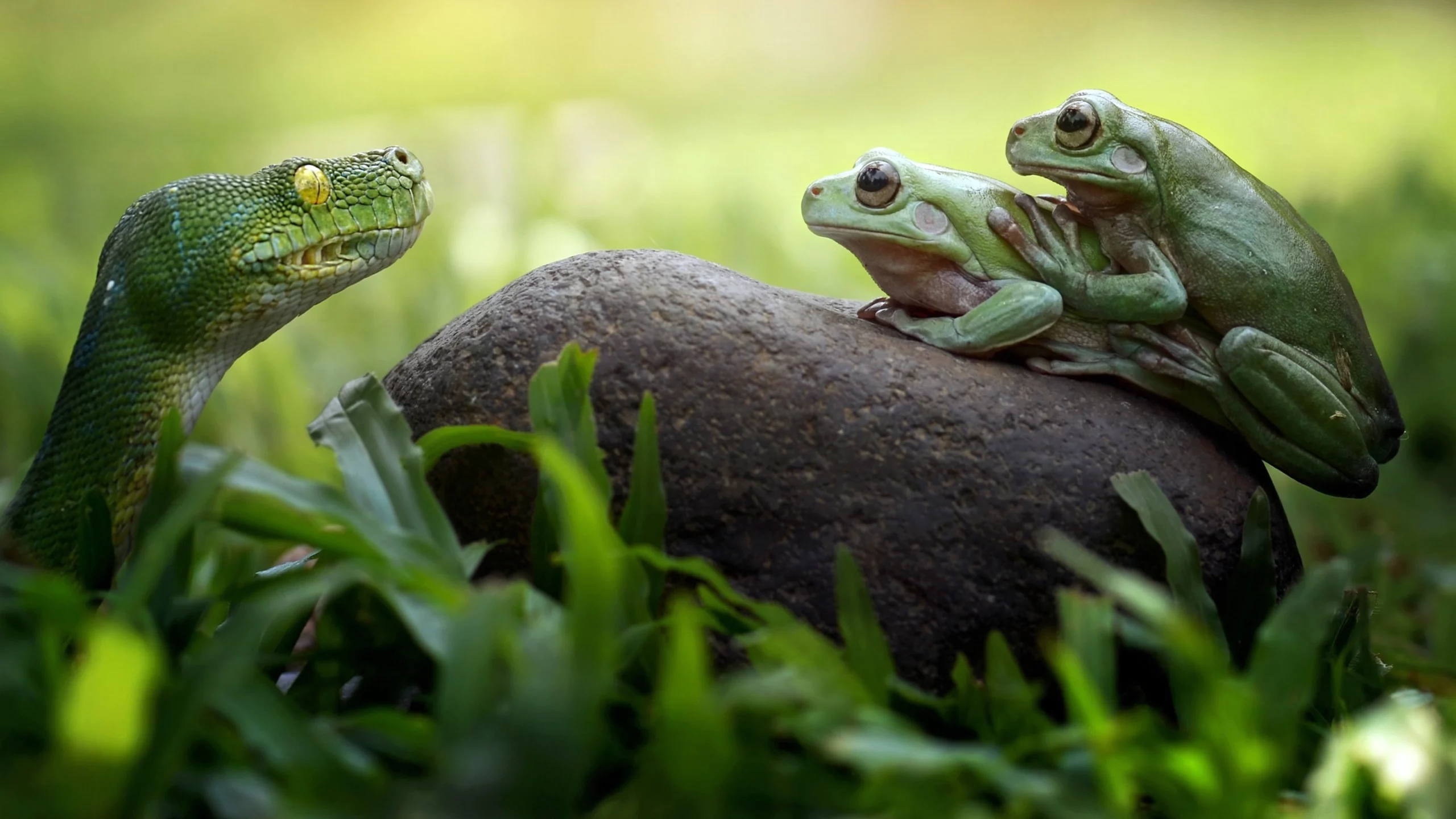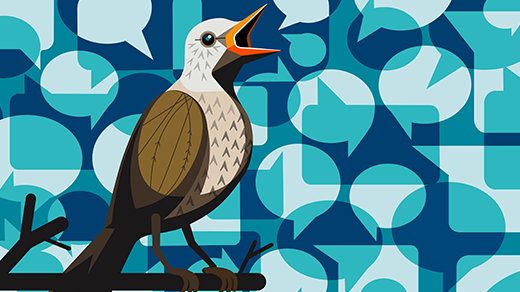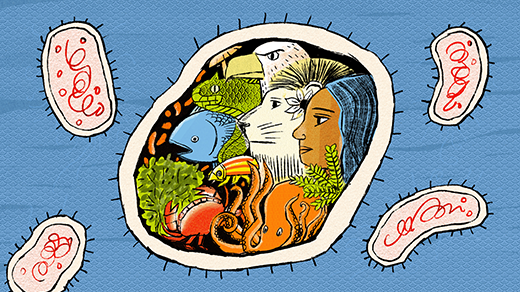How Genes Can Leap From Snakes to Frogs in Madagascar

A gene that originated in snakes has repeatedly jumped the species barrier into frogs around the world. Researchers are trying to understand why it happened in Madagascar far more often than anywhere else.
Fahmi Bhs
Introduction
Perched on a leaf in the rainforest, the tiny golden mantella frog harbors a secret. It shares that secret with the fork-tongued frog, the reed frog and myriad other frogs in the hills and forests of the island nation of Madagascar, as well as with the boas and other snakes that prey on them. On this island, many of whose animal species occur nowhere else, geneticists recently made a surprising discovery: Sprinkled through the genomes of the frogs is a gene, BovB, that seemingly came from snakes.
After poring over genomes from frog and snake species around the world, the scientists reported in April in a paper in Molecular Biology and Evolution that this gene has somehow traveled from snakes to frogs at least 50 times all over the planet. But in Madagascar it has inserted itself into frogs with startling promiscuity: 91% of the frog species sampled there have it. Something seems to make Madagascar an exceptionally conducive place for the gene to get mobile.
When Atsushi Kurabayashi, an associate professor at the Nagahama Institute of Bio-Science and Technology and the senior author of the new paper, first saw the snake version of the gene in frogs, he was puzzled. He asked a colleague who specializes in genomics about it, and the colleague immediately shouted, “It must be horizontal transfer!” — the transfer of a gene from one species to another, in contrast to the vertical inheritance of genes by a child from a parent.
That outburst sent Kurabayashi on the trail of a phenomenon once thought to be exceedingly rare, though the rise of better genomic sequencing has biologists reevaluating that opinion. And this new paper, which shows that the horizontal transfer of genes may be more likely in some places than others, complicates the story even more. It suggests that when seeking explanations for horizontal transfers, researchers may need to look beyond simple genetic mechanisms to the ecological contexts in which species live. Genomicists are still struggling to understand how common or rare horizontal transfers are in complex organisms, but some places, like Madagascar, may be hot spots for them.


Researchers suspect that the version of the BovB gene found in boas (center) and other snakes in Madagascar may be particularly adept at making horizontal transfers. The painted reed frog (top) and the golden mantella frog (bottom) are two of the many species of frogs that have acquired BovB.
Researchers suspect that the version of the BovB gene found in boas (center) and other snakes in Madagascar may be particularly adept at making horizontal transfers. The painted reed frog (left) and the golden mantella frog (right) are two of the many species of frogs that have acquired BovB.
When Genes Wander
Horizontal transfer is commonplace in bacteria. The teeming single-celled organisms that populate nearly every cranny on the planet pick up genes from their environment as easily as a lint brush picks up cat hair. That’s one reason why bacterial resistance to antibiotics is widespread: Protective genes are passed around easily, and natural selection ensures that the resistant bacteria outcompete their neighbors and pass their genes on to the next generation. Bacteria swap genes so readily that some scientists have even proposed that bacteria form a web of related life rather than a branching family tree.
The cells of eukaryotic organisms like humans, frogs and snakes, however, are different. Their cell nucleus usually seems like a fortress for protecting the genome. The DNA is carefully coiled up and stored in that citadel’s library, with enzymes calling forth only the genes they need to examine at any given time. The cell is loaded with fail-safes to prevent damage to its DNA and to repair wear and tear. If the genome is like a priceless illuminated manuscript, its librarians carry swords.
Nevertheless, examples of horizontal gene transfers involving eukaryotes keep trickling into the scientific literature. Herrings and smelts, unrelated fish that swim in the icy waters of the Arctic, northern Pacific and northern Atlantic oceans, have precisely the same gene for a protein that keeps their blood from freezing; it likely jumped from herrings into smelts. Laurie Graham, a molecular biologist at Queen’s University in Canada, and her colleagues reported it last year; their findings were so counterintuitive that Graham had difficulty getting the work published.
Similarly, the evolutionary biologist Etienne G.J. Danchin and his colleagues at the National Research Institute for Agriculture, Food and Environment in France are studying a suite of enzymes that nematode worms got from bacteria. And over 100 gene families appear to have leapt from microbes to plants long ago, wrote Jinling Huang of Eastern Carolina University and colleagues in a paper this year.
There are beautifully clear reasons why evolution smiled on some of these improbable transfers. The fish with the gene don’t freeze. The nematodes’ digestive enzymes enable them to wring more energy from the cells of the plants they eat. Because of a cluster of enzymes picked up from bacteria, the hot spring-dwelling red algae studied by the evolutionary biologist Debashish Bhattacharya and his student Julia Van Etten at Rutgers University can survive contact with substances that would otherwise kill them. If a gene boosts survival, it doesn’t take long before the descendants of the first organism to acquire it take over.
Not all these wandering genes, however, necessarily convey an advantage. BovB is a well-known transposon, a scrap of genetic material prone to jumping randomly around the genome. In a way, its jumps from snakes into frogs in Madagascar — however they occurred — are just bizarrely bigger leaps than usual. Moreover, although transposons can have profound effects on genomes, BovB isn’t a gene with a function in the traditional sense; it’s just a bit of DNA that makes copies of itself. Kurabayashi notes that although the possibility that BovB benefited the frogs can’t be ruled out, it’s more likely that BovB persists through its own aggressive success at self-duplication. This may help to explain why it is that when eukaryotes wind up with other organisms’ genetic material, transposons like BovB are often involved.
As strange as it might seem for eukaryotes to pick up genes from bacteria, stranger still is the fact that examples of horizontal gene transfer in the other direction are vastly rarer. For some reason, bacteria don’t want our genes. Eukaryotic genes have structural features that make them less than perfect material for bacteria, but there may be other contributing factors as well.
“Maybe eukaryotes don’t have the genes that bacteria are interested in,” said Patrick Keeling, a biologist at the University of British Columbia who studies horizontal transfers.
Going Viral
Unlike bacteria, viruses have a real knack for picking up genes from their eukaryotic hosts. Viruses, particularly the ones called retroviruses, have the tools for getting into a host’s cells and nuclei, and they are masters of inserting genetic material into host genomes. Up to 8% of the human genome is made up of the leftovers of retroviruses, fragments of long-ago infections in our species’ history.
Merrill Sherman/Quanta Magazine
Sometimes the transfer goes the other way, too. In a paper published in Nature Microbiology last December, Keeling, his collaborator Nicholas Irwin of the University of Oxford and their colleagues performed the first comprehensive analysis of horizontal gene transfers between 201 eukaryotes and 108,842 viruses. They found evidence for more than 6,700 gene transfers, with host-to-virus transfers about twice as common as virus-to-host transfers. They concluded that horizontal gene transfers had been major drivers of evolution on both sides: Viruses often used the eukaryotic genes they acquired to become more effective at infecting their hosts, while eukaryotes sometimes used elements of the viral genes to create novel features or to regulate their metabolisms in new ways.
Findings like these have persuaded some biologists that at least some horizontal gene transfers may be facilitated by viruses. If viruses can pick up genes from their hosts, and if they can leave behind pieces of their genomes, it seems possible that they could also sometimes ferry over genes from the last host they infected, or even one from generations ago, and give them to a new host.
The involvement of viruses could also help to solve another puzzle about horizontal transfers in eukaryotes. For the transfers to occur, the traveling genes need to clear an entire series of hurdles. First they must get from the donor species to the new host species. Then they must get into the nucleus and ensconce themselves in the host genome. But getting into the genome of just any cell won’t do: In multicellular creatures like frogs and herrings, a gene won’t be passed down to the animal’s offspring unless it can sneak into a germline cell — a sperm or an egg.
Viruses might make that series of events more likely. In small organisms like the nematode, Danchin said, the reproductive tract and its germ cells are not far from the intestinal tract, where viruses ingested on food can settle. Because frogs release their eggs and sperm into the open water, those cells are potentially vulnerable to viruses in the environment that could slip in genes.
Even with larger creatures, it might be easier than you think. At this point, it’s still a speculative idea, but “the reproductive tract is full of microbes and viruses,” Danchin said. “We know some viruses infect specifically the reproductive tract.”
Keeling suggests that to understand the mystery of horizontal gene transfer, perhaps we should think of them as ecological consequences of an organism’s behaviors, its neighbors and its environment. If a horizontally transferred gene confers any survival benefit, it’s likely to be highly contingent on the specific scenario in which the recipient of the gene finds itself — an icy sea, a hot spring, an appetizing host plant with tough defenses. “They’re so tied to the ecology where that thing is, but it changes,” he speculated. With the wrong shift in the environment, the transferred gene “is no longer advantageous, and it’s lost.”
Ecological Clues
Horizontal gene transfers in eukaryotes may be happening all the time: in the pond in your backyard, in the soil beneath your feet, in the animals, insects and plants that make up the ecosystem. “I think there is way more transfer than we know,” Bhattacharya said. “We just don’t see them because they are swept out.”
To check how common it is for frogs to have snake BovB, Kurabayashi’s team reached out to their colleagues for samples of frogs from around the world for DNA sequencing. They found that out of 149 species, 50 came back with BovB. The 32 Malagasy frogs that they tested made up less than a quarter of all the species sampled, but 29 of them carried the snake gene — a clear majority of all the transfers found around the world. Moreover, at least two of the frog lineages didn’t acquire BovB until after their ancestors migrated from Africa to Madagascar.
The most interesting thing about the paper, Graham said, “is it’s showing the rate of transfer is not uniform. It varies widely among geographic regions.” If more studies set out with the goal of looking at gene transfer around the globe — seeing whether transfers have happened at different rates in different places — what we find may surprise us. Perhaps geography matters more than we might expect.
Is there something about the environment of Madagascar that makes it a hot spot for gene transfers? No one knows. Kurabayashi says that he and his group suspect most strongly that the snake BovB in Madagascar differs from versions elsewhere in the world in being just a little bit better at getting itself into a new host.
But the abundance of parasites on the island might also be a contributing factor. For example, “in Madagascar, there are lots of leeches,” said Miguel Vences, a herpetologist at the Braunschweig University of Technology in Germany and an author of the new paper. “If you’re in the rainforest, you will notice them.” The bloodsucking creatures feed on many types of animals, including frogs and snakes, and they are not above sampling humans. Vences and his colleagues speculate that leeches may bring blood containing the snake’s jumping gene into the frogs, or perhaps the jumping gene is already in the leech’s own genome from previous contacts with snakes. Then maybe an unidentified virus does the rest.
Unfortunately, it isn’t easy to prove or disprove scenarios describing how such horizontal transfers might have occurred. Without selection to preserve DNA sequences, they tend to mutate and get scrambled over long stretches of time, erasing the molecular evidence of a transfer. And if a virus is involved in the transfer, it may leave very little evidence in the first place, Graham said. Researchers might therefore almost need to catch a genetic jump in the act to know how it is happening.
Bhattacharya is in the early stages of a project aiming to do just that. In the hot springs at Lemonade Creek in Yellowstone National Park, he and his colleagues are looking for signs of transfers that may still be in the process of taking hold. They are studying the DNA of red algae that have picked up genes from bacteria that also live in the springs, genes that bear only small differences from the originals. “We’re not talking about millions of years ago,” said Bhattacharya. “We’re talking about DNA that’s highly similar, that coexists in two different domains of life, in the same environment.”
If the scientists find that algae in nearby springs lack any of these transferred genes, then they may be witnessing the beginning of a ripple of genetic change moving outward through the algae, from one neighboring spring to the next. Each new hot pool may be an island on the brink of a transformation.



